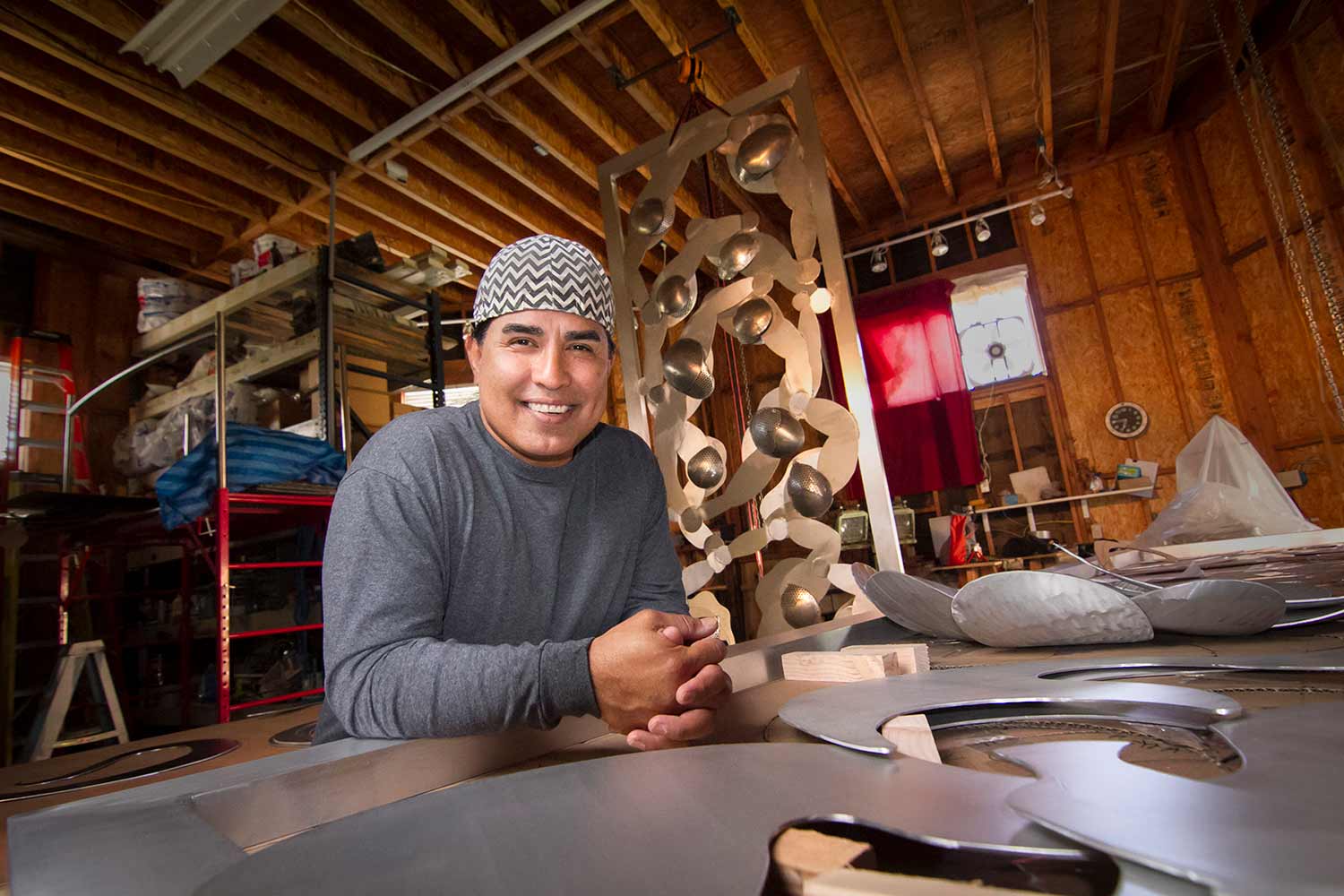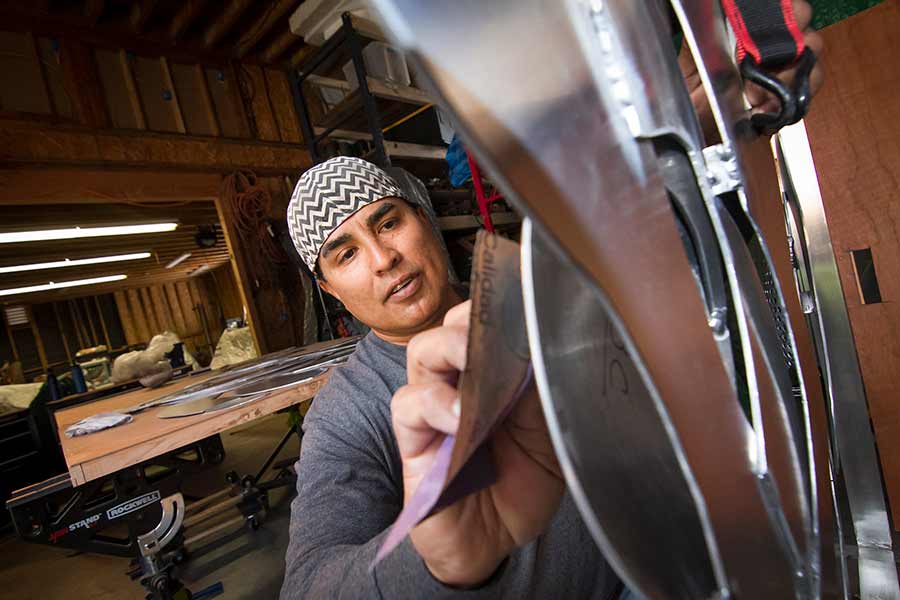
By:
- Erika Johnson
Published Date
By:
- Erika Johnson
Share This:

Artist Johnny Bear Contreras, member of the San Pasqual Band of Mission Indians. Photos by Erika Johnson/UC San Diego Communications
When the World Comes to Life
New UC San Diego sculpture blends Native American culture with sustainability and gender diversity
Johnny Bear Contreras can recall with perfect clarity the moment the world came to life for him. He was working high atop the mountains in the ski town of Mammoth Lakes. For weeks, the sky had been heavy with clouds, gray and unyielding. But one day, Contreras looked up and the skies broke apart. The artist saw four individuals hovering above and a glimpse of stars in between. The vision triggered a new direction in his life; he hurried home to sketch what he had just experienced. Nearly 30 years later, Contreras is bringing the sketch to life as a sculpture that will be displayed in the central quad of UC San Diego’s Muir College.
“I refer to myself as a storyteller,” said Contreras, an artist and member of the San Pasqual Band of Mission Indians. “As the stories have been told to me, I try to continue that path and express them in the best ways I can.”
The UC San Diego campus community and local San Diego residents are invited to attend the official unveiling of the sculpture from 9:30-11:30 a.m. on June 6. The event will include California Indian bird singers, a blessing and a reception. Contreras’ artwork, called “When the World Comes to Life,” is comprised of two large aluminum panels that will be attached to the west wall of Stewart Commons in Muir Quad.
The three-dimensional metal panels are layered with intricately cut figures, plants and birds in both abstract and representational styles. On one side, individuals are intertwined, almost as if they are dancing. As the male and female forms meet in the middle, they become more androgynous, representing the gender spectrum, family and community. The second panel features traditional Kumeyaay bird singers with their gourds. Marine plants and aquatic flowers flow between them, signifying the importance of the sea to many indigenous people, particularly in the local region.
“I wanted it to have the flow of paint but have more dimension to it,” said Contreras, who enjoys working in different mediums. For him, the piece reflects a new direction, an irresistible call to the west. In many Native American cultures, each cardinal direction is characterized by a color—west being black. The sculpture, which faces west, will incorporate a darker patina with burnished highlights, reflecting as the sun sets.
The sculpture is the first artwork on campus by a Native American artist, and acknowledges that the university is located on the traditional territory and homelands of the Kumeyaay Nation. San Diego County is home to approximately 18 American Indian reservations—more than any other county in the United States. “This is Kumeyaay land—I want our youth to feel connected, to know that where they are is where they come from,” explained Contreras. “It’s only appropriate that we have something here that symbolizes the growth that is always taking place, recognizing the people and their customs and traditions.”
The project was set in motion when two UC San Diego undergraduate students, Alexandra Harbert and Roy Velasquez, decided they wanted to see more art around Muir College. Their initial goal was to find an indigenous artist and to incorporate messages that were meaningful to students on campus. The duo formed an advisory committee of faculty, staff and students to garner feedback about what themes are important for them to see. They had conversations with the Native American Student Association, members of the LGBTQIA+ Living Learning Community (housed in Muir College), campus community centers and more. The ideas that surfaced included sustainability in acknowledgement of the college’s namesake, environmentalist John Muir, as well as sexuality, community and the gender spectrum.

The three-dimensional metal panels are layered with intricately cut figures, plants and birds in a style meant to evoke the flow of paint.
Once they solidified their concept, they began seeking an artist that could bring their vision to life. It was during a meeting with Stan Rodriguez, a UC San Diego doctoral student and member of the Santa Ysabel Band of Iipay Nation, at the Intertribal Resource Center that Harbert and Velasquez discovered the work of Contreras. “We wanted to provide a space with more expression, but that still fits with Muir’s general design,” said Harbert. “Roy and I were really excited to meet Johnny because we had been looking for a Kumeyaay artist. He understood the direction we wanted to go even though we had a hard time describing it ourselves.”
The new work joins a growing collection of public art at UC San Diego that celebrates culture and influential social justice leaders. These include a life-size bronze sculpture of suffragist and abolitionist Sojourner Truth, a 17-by-54-foot mosaic mural that represents the history of the Chicanx movement, as well as a Black Legacy Mural that portrays more than two dozen historical figures, from Harriet Tubman to Nelson Mandela and Angela Davis. The works are meant to promote reflection and inspire the next generation to continue the legacy of social justice.
Share This:
You May Also Like
Stay in the Know
Keep up with all the latest from UC San Diego. Subscribe to the newsletter today.


